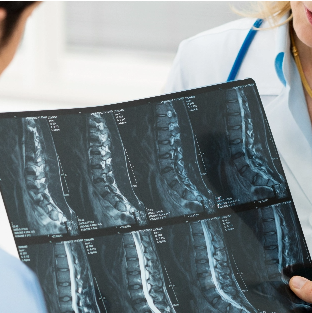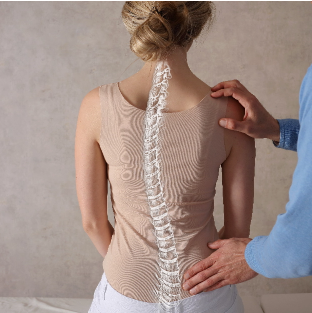Hello, I'm Dr. Jeremy Smith, a spine surgeon in Orange County with 18 years of experience in treating scoliosis and sciatica. I've seen how these conditions affect people's lives, and in this article, I'll demystify the relationship between scoliosis and sciatica. We'll explore their connection, implications, and available treatment options.
Unraveling Scoliosis
Scoliosis, simply put, is an abnormal curvature of the spine. It can give the spine an 'S' or 'C' shape and often begins during adolescence, but scoliosis can affect adults too. People with scoliosis might notice uneven shoulders, a tilted waist, or hips that aren't level. In severe cases, it can lead to pain and trouble moving around. The exact cause of scoliosis varies; it can be from unknown origins (idiopathic), present since birth (congenital), occur with age (degenerative), or related to muscle and nerve issues (neuromuscular). The severity can range from minor curves to significant deformities.
Exploring Sciatica
Now, let's talk about sciatica. The term “sciatica” is often used outside of the medical world to refer to a condition that is more appropriately termed, “radiculopathy”. Radiculopathy refers to the pain, numbness, and tingling down an arm or leg that is associated with nerve compression or nerve irritation. When we refer to “sciatica” in the medical field, we are discussing irritation or inflammation of the sciatic nerve, the longest nerve in your body. This nerve runs from your lower back all the way down to your feet. When it's irritated or compressed, it can cause pain, numbness, and tingling, usually on one side of your body, down the buttock, into the back of the leg, and sometimes all the way down into the foot. The culprits behind radiculopathy and sciatica can include herniated disks, bone spurs, and yes, sometimes, spinal conditions like scoliosis. For the sake of familiar language, we will use the term sciatica and radiculopathy interchangeably for this blog. However, it is important to make the distinction between sciatica and radiculopathy, as above.
The Intricate Relationship Between Scoliosis and Sciatica
Although scoliosis and sciatica are separate issues, they often intersect within the world of spinal disorders. The unusual spinal curve in scoliosis can create uneven pressure on your vertebrae and discs, possibly leading to herniations or bone spurs that press on the sciatic nerve. Whether you experience sciatica or not can depend on the degree of your spinal curvature and the specific shape of your scoliotic spine. Furthermore, your body's efforts to adapt to scoliosis can sometimes worsen or trigger sciatic discomfort.
Recognizing Signs of Scoliosis
It's crucial to be aware of the signs that may indicate scoliosis. If you suspect you have scoliosis, watch out for the following indicators:
- Uneven Shoulders: One of the common signs of scoliosis is uneven shoulder heights. Stand in front of a mirror and check if one shoulder appears higher than the other.
- Tilted Waist or Hips: Scoliosis can cause your waist or hips to tilt to one side, creating an asymmetrical appearance. Sometimes this is discovered when clothes start to fit differently.
- Pain or Discomfort: Scoliosis can lead to discomfort or pain, especially in the lower back region. If you experience persistent pain in this area, it's worth investigating.
- Difficulty with Movement: As scoliosis progresses, it can hinder your ability to move comfortably. You might find it challenging to bend, twist, or perform daily activities.
To confirm the presence of scoliosis, a thorough examination is essential. This typically includes:
- Physical Examination: During a physical examination, your healthcare provider will assess your posture, spinal alignment, and any visible asymmetry.
- Medical History Review: Your medical history can provide valuable insights into the development and progression of scoliosis. Mention any family history of the condition.
- Imaging Tests: To gain a comprehensive understanding of your spine's structure and detect any nerve compression, imaging tests such as X-rays, CTs, or MRIs may be conducted. These tests help in assessing the degree of spinal curvature and identifying any underlying issues.
Recognizing Signs of Sciatica
Similarly, it's important to recognize signs that may suggest the presence of sciatica. If you suspect you have sciatica, be vigilant for the following symptoms:
- Pain Radiating Down the Leg: Sciatica often manifests as a sharp, shooting pain that radiates from the lower back down one leg. This pain can be intense and may worsen with movement or prolonged sitting.
- Numbness and Tingling: You might experience numbness, tingling, or a "pins and needles" sensation in the leg affected by sciatica.
- Muscle Weakness: Sciatica can lead to muscle weakness in the leg, making it challenging to walk or perform certain activities.
To confirm the presence of sciatica, a comprehensive evaluation is necessary. This typically includes:
- Physical Examination: A physical examination helps your healthcare provider assess your range of motion, muscle strength, and areas of tenderness. They will also check for any specific neurological signs.
- Medical History: Sharing your medical history, including when the symptoms began and any relevant medical conditions, can aid in diagnosis.
- Imaging Tests: Imaging tests such as X-rays, CTs, or MRIs may be employed to visualize the spine and pinpoint the cause of sciatic nerve compression. These tests help in identifying conditions like herniated disks or bone spurs that can contribute to sciatica.
Being attentive to these signs and promptly seeking medical evaluation can facilitate early diagnosis and appropriate treatment for both scoliosis and sciatica.
Treatment Approaches
The treatment for scoliosis and sciatica varies based on factors like how severe they are, your age, and your overall health. In many cases, we begin with conservative treatments like physical therapy, targeted exercises, and pain management techniques. These methods focus on strengthening the muscles around your spine, improving your posture, and relieving pressure on your nerves. However, for more severe situations, especially when your quality of life is significantly affected, we might consider surgical options. These can range from less invasive procedures to more complex surgeries like spinal fusion.
Living with Scoliosis and Sciatica
Effectively managing these conditions necessitates a proactive approach to spinal health. Regular check-ups, a tailored exercise routine, and mindfulness about your posture all contribute to managing your symptoms and improving your quality of life. Additionally, staying well-informed about your condition and treatment options, and connecting with a supportive community or group, can make a significant difference in dealing with both the physical and psychological challenges.
Practical Tips for Individuals Living with Scoliosis and Sciatica
- Maintain good posture while sitting and standing.
- Use ergonomic furniture and tools to reduce strain.
- Engage in low-impact exercises like swimming or yoga.
- Prioritize a balanced diet and stay hydrated.
- Seek professional medical advice for proper diagnosis and treatment.
The interplay between scoliosis and sciatica is complex and varies from person to person. Understanding this connection is crucial for effective management and treatment. As a spine surgeon, my goal extends beyond addressing physical symptoms; I aim to enhance your overall well-being and functionality. If you've been experiencing any of the symptoms mentioned in this article or have concerns about your spinal health, don't hesitate to reach out. I, Dr. Jeremy Smith, am here to help. With years of experience as an Orange County spine surgeon, I specialize in diagnosing and treating conditions like scoliosis and sciatica.
Your journey to a pain-free and active life begins with a simple step: contacting our team for a consultation. Take charge of your well-being today. Call (714) 937-2105 or click here to schedule an appointment. Don't let spinal discomfort hold you back – my team is here to assist you every step of the way.
FAQs
Can sciatica be solely caused by scoliosis?
While sciatica can occur alongside scoliosis, it's not typically caused solely by scoliosis. Sciatica is often a result of nerve compression, which can happen when a herniated disc or other factors affect the sciatic nerve. Scoliosis may increase the risk, but it's usually not the sole cause.
How frequently do scoliosis patients experience sciatica?
The frequency of sciatica in scoliosis patients varies. It depends on factors like the degree of spinal curvature and individual anatomy. Some with scoliosis may never experience sciatica, while others might if the curvature leads to nerve compression. Regular monitoring and early intervention are essential. Sometimes, sciatica can cause scoliosis, because the body naturally tries to lean away from the area of nerve compression, resulting in an unnatural curvature in the spine.
Are there specific exercises that can benefit individuals dealing with both conditions?
Yes, specific exercises can help individuals manage scoliosis and sciatica. Exercises focused on strengthening core and back muscles, improving posture, and increasing flexibility can provide relief. However, it's crucial to consult a healthcare professional or physical therapist to develop a tailored exercise plan.
To what extent does the severity of scoliosis affect the likelihood of developing sciatica?
The severity of scoliosis can impact the likelihood of developing sciatica. A more pronounced spinal curvature can increase the risk of nerve compression and sciatic symptoms. However, it's not the sole determinant, as individual factors and overall spinal health also play a role.
What surgical options are available for severe cases?
For severe scoliosis cases with associated sciatica or significant discomfort, surgical options may include spinal fusion, decompression procedures, or correction of the spinal curvature. The choice of surgery depends on various factors and requires a thorough evaluation by a spine specialist.
Can children with scoliosis develop sciatica, and if so, how is it managed?
Yes, children with scoliosis can develop sciatica, although it's relatively rare. Management typically starts conservatively with physical therapy, back pain management, and monitoring. Surgical intervention may be considered for severe cases that don't respond to non-surgical treatments, but it's essential to consult with a pediatric spine specialist for the best approach.

















